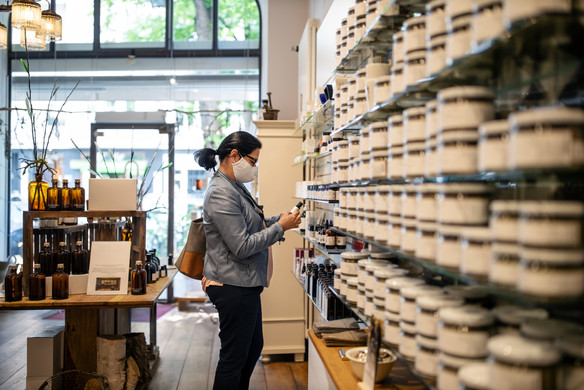Table of contents
For many people, making decisions this year has felt more difficult than usual. From feeling anxious to overwhelmed, there could be an explanation for why choosing between two items at the grocery store might cause you or your customers to give up and leave empty-handed — it is called analysis paralysis.
Psychology Today says that for a person experiencing analysis paralysis, deciding where to go out to eat can feel “as important and overwhelming” as changing careers. Analysis paralysis stems from the fear of making a wrong decision, and this can feel especially compounded in today’s world because of the stress of the COVID-19 pandemic.
People experiencing analysis paralysis feel paralyzed making decisions and cannot decide on a course of action. This ranges from huge life changes to smaller choices like buying a gift for someone or picking a restaurant for dinner.
There was a time when consumer options were limited — if you wanted a particular item, you went to the store and bought that item from the one brand offering it. Not only are there more items and more stores to choose from now but also consumers can shop in person, do curbside pickup, shop online, or buy through social media. These different avenues from which to shop have become an even bigger decision with pandemic-related safety concerns.
As a retailer or service provider, there are important things to know about analysis paralysis and what you can do to help consumers who are paralyzed with indecision.
The paradox of choice
Psychologist Barry Schwartz brought the phrase “the paradox of choice” into prominence by focusing on the idea that narrowing choices for consumers could reduce their anxiety.
In a TED Talk about the book he talks about how our society perceives freedom and choice. The more choices you have, the more freedom you have. However, Schwartz says that having all of these choices can actually cause “paralysis, rather than liberation.”
“With so many options to choose from, people find it difficult to choose at all,” says Schwartz. This is compounded by the fact that consumers have so much information at their fingertips. There are reviews available online for nearly anything you can think of. Consumers are constantly bombarded with information through social media, TV, and online ads.
On top of having many purchasing options and an overwhelming amount of information, consumers aren’t sure whether to shop in person, use curbside pickup, or shop only online. Each purchasing option comes with its own set of risks.There is also a lot of conflicting information about changing regulations around the pandemic that varies by location.
The fear of being wrong
In addition to being overwhelmed by the sheer volume of information, consumers have also started to second-guess themselves out of fear they may make the “incorrect” choice. Though there may not be a right or wrong choice, with so many similar options, making the “right” choice as a consumer is difficult.
“The second effect [of too many choices] is that even if we manage to overcome the paralysis and make a choice, we end up less satisfied with the result of the choice than we would be if we had fewer options to choose from,” says Schwartz, adding, “The more options there are, the easier it is to regret anything at all that is disappointing about the option that you chose.”
Now that people are concerned about their health and safety more than ever, the “right” choice could become a matter of health and safety in consumers’ minds. Could selecting the “wrong” mask lead to COVID exposure? Is eating outside or engaging in curbside delivery a risk? This “wrong” choice could lead to consequences for their health, so much so that some consumers may stay home out of fear.
There are several ways your business can combat consumers’ analysis paralysis and help them make a shopping or purchasing decision.
Emphasize safety. To assuage fears about COVID-19, make sure your safety guidelines and protocols are displayed up front, whether that be on the physical storefront of your business or a prominent place on your website. Highlight the safe options you have put in place so that people can choose what makes them most comfortable.
Reduce the choices. Once you have conveyed how you are keeping customers safe, it’s time to simplify your customers’ choices. One way is to curate a section called “staff picks,” which lets customers feel like an expert is pointing them toward high-quality products. Another category might be “top quality bargains” or “best-reviewed items,” to give customers the feeling of getting a good deal or relying on what other customers have found to be good choices. According to CXL, having three options is the sweet spot for helping consumers make a choice for just about anything.
Ask customers for their input. For truly indecisive customers, a brief survey that yields three purchasing suggestions could be a beneficial tool. The survey forces customers to narrow down what they are looking for, make small decisions quickly, and use their gut reaction, all things that Psychology Today suggests as ways to combat analysis paralysis.
In-store, an employee can act as the survey by asking the customer a few questions about what they’re shopping for and helping them narrow things down. As Schwartz says, it helps consumers find the “sweet spot that enables people to benefit from variety and not be paralyzed by it.”
Simplify your displays. Visually, both your in-store displays and website should be clean and simple so as not to overwhelm your customers. A few products with simple information about them up front can make shopping more accessible. Consumers can find more in-depth information by asking an employee or clicking a link without being overwhelmed during their initial search.
Reassure the customer. Try to convey to your customers that they have made a good decision — a little positive reinforcement can go a long way. Maybe it happens in the form of a pop-up window on your website that highlights positive reviews of the chosen product, or in your brick-and-mortar store, assure your customers that they have made a great choice.
![]()











